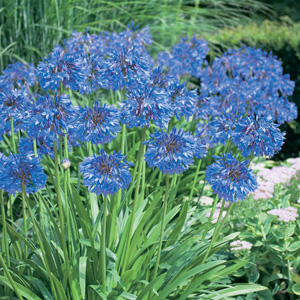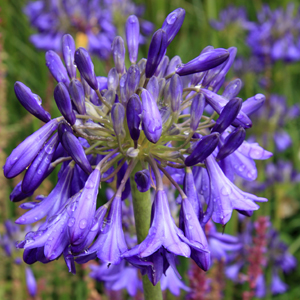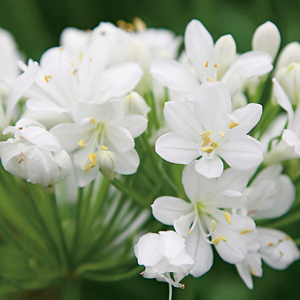Agapanthus Growing Guide

What is Agapanthus?
Agapanthus (Agapanthus spp.) also known as the African Lily or the Lily of the Nile is a fleshy rooted perennial. It is part of the Liliaceae family and is native to Southern Africa. Agapanthus come in a wide variety such as evergreen and deciduous to tall and dwarf. All have a dense fleshy root system that produces arching, strap-like, dark green foliage in a clumping habit. During mid Spring to early Summer tall flower spikes will emerge with round umbels of brightly coloured flowers.The flowers are tube to bell shaped in shades of blue to purple or white. If your Agapanthus isn’t flowering it might be in too much shade as they prefer to be positioned in full sun.
Note that this plant can be potentially invasive in some regions, so should not be planted near bushland or other sensitive areas. Check local government restrictions. As necessary, plant sterile or low-seeding varieties (such as Black Pantha).
Benefits of Growing Agapanthus
Agapanthus are perfect for the beginner gardener as they require low maintenance and will grow without any fuss. They are hardy and are tolerant of drought and poor soil. They are ideal plants for borders, beside fences and along driveways. Dwarf forms are superb in rockeries or containers.
How to Grow Agapanthus
Climatic Zones
Cool to mild tropical.
Plant Size
Dwarf Varieties Height: 45cm, Width: 30cm
Tall Varieties Height: 1.5m, Width: 50cm
When To Plant Agapanthus
Soil Preparation
How To Plant Agapanthus
Plant in full sun however will tolerate part shade but flowering will be compromised. Plant 60cm apart for tall varieties, and 30cm for dwarf varieties with the plant crown at soil level.
When planting in pots, root congestion is not a major concern, as Agapanthus plants tend to respond quite well to this. When the roots have too much space, leaf growth will be encouraged rather than flower production.
Agapanthus Plant Care
Water well during establishment. They are a drought tolerant plant so only water to supplement rainfall if required.
Fertilising is not usually required, but you can use a complete fertiliser in Winter or Spring.
Remove flower heads after flowering to prevent seeding in unintended places. Clean up and remove any yellowing leaves.
Agapanthus clumps can be thinned out and replanted immediately after flowering. Propagate through dividing can be done in late Winter or after flowering. They are tough so you can dig them right out and just slice them in half or quarters with a spade and re-plant them.
Generally resistant to pests and disease, however snails and slugs can be a problem.
Recommended Agapanthus Varieties
Producing an abundance of bright purple, blue and white flowers, makes them a beloved addition to many gardens.










